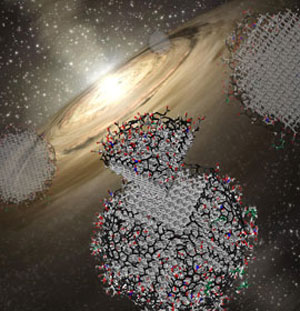| Jan 11, 2012 |
A review of nanodiamond research
|
|
(Nanowerk News) Nearly 50 years ago scientists discovered that detonating powerful explosives had the ability to create, not just destroy. Nanodiamonds, diamond-structured particles measuring less than 10 nanometers in diameter, which are the resultant residue from a TNT or Hexogen explosion in a contained space, are now being studied in a variety of science, technology and health applications. A team of researchers who specialize in nanotechnology, led by Dr. Yury Gogotsi, director of the A.J. Drexel Nanotechnology Institute, offered a review of nanodiamond research, in the December 18 edition of Nature Nanotechnology ("The properties and applications of nanodiamonds ") to sift through new ways scientists are using these tiny treasures.
|
 |
| Miniscule diamond particles called nanodiamonds can be formed by contained explosions on Earth and have also been found in protoplanetary clouds surrounding certain stars and meteorites.
|
|
The authors, who also include Dr. Vadym Mochalin, assistant research professor of materials science at Drexel, Dr. Olga Shenderova senior scientist and head of the Nanodiamond Laboratory at the International Technology Center (ITC) and Dr. Dean Ho, associate professor of biomedical and mechanical engineering at Northwestern University, survey a rapidly growing field of fundamental and applied research as well as technological development surrounding nanodiamonds.
|
|
"We examine the importance of nanodiamond in biomedical, optical, composites, lubricants and other applications," Gogosti said. "The success of nanodiamond materials in biomedical applications stems from the fact that many small molecules such as proteins, antibodies, therapeutics and nucleic acids can bind to the surface of nanodiamonds, making it an ideal candidate for use in drug-delivery and surgical implants."
|
|
According to the piece, nanodiamonds possess a unique combination of qualities, such as accessible surface area, versatile chemistry, chemical stability and biocompatibility. These traits, and the fact that nanodiamonds are non-toxic, make the particles ideal candidates for a variety of tasks including drug delivery cancer diagnostics, and mimicking proteins.
|
|
"Rich and very versatile surface chemistry, which can be and, actually, needs to be tailored for each particular application of nanodiamond, makes possible matching this material to a variety of environments, ranging from oil to water and polymers," Mochalin said. "This is especially important when considering nanodiamond's application in drug delivery and polymer composites for tissue engineering scaffolds."
|
|
Specific uses mentioned in the group's survey of the research include using nanodiamonds for targeted therapy and imaging, two applications essential to the treatment of cancer. The article notes that preliminary studies in mice have shown that drugs mediated with nanodiamond were able to reduce a tumor's ability to resist the drug treatment.
|

